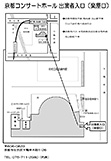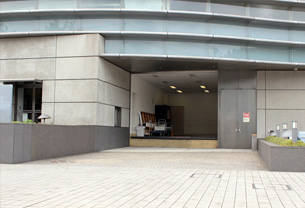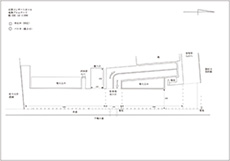FACILITY INTRODUCTION
-
Symbol mark

The symbol mark represents a scroll of the stringed instrument which is expressing the passage of time of Kyoto flowing from the past to the future. The strings playing the melody run through the design.
| Address | 1-26 Shimogamo Hangi-cho, sakyo-ku, Kyoto | ||
|---|---|---|---|
| Architectural design | Arata Isozaki & Associates | ||
| Acoustical design | Nagata Acoustics Inc. | ||
| Overview of Facilities |
Plottage | 9,900 m2 | |
| Total floor area | 22,412 m2 | ||
| Ferroconcrete construction, part steel structure | 5 floors aboveground; 2 basement levels | ||
-
Kyoto Concert Hall(Main Hall)
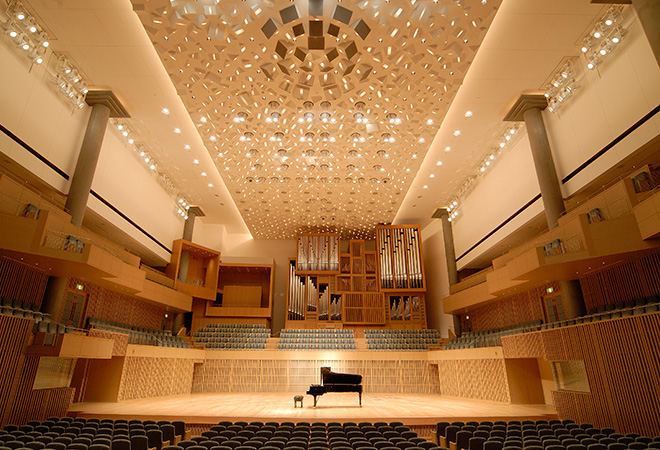
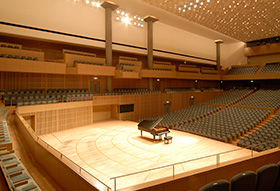
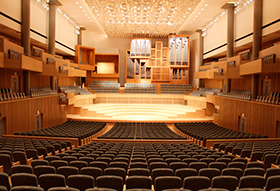

Seating for 1,839 (includes 6 wheelchair places) Foyer and cloakroom 4 private dressing rooms ; 2 small dressing rooms ; 5large dressing rooms ; piano storage room
The “shoe-box-style” auditorium is the traditional architectural design adopted by a number of the world’s most illustrious symphony halls, as for example those of Vienna and Boston. To this time-honored shoe-box configuration we have added modern refinements to fashion a truly magnificent acoustic space, capable of melding the performers on stage and their 1,800-member audience into a single, pulsing entity. From the very first note of a performance, the entire hall resonates as though bursting into song. This is a hall that awakens every sense in the body to full and vibrant life.

Pipe Organ
The commanding presence at the head of the stage in the Concert Hall is Kyoto Concert Hall’s 90-stop pipe organ, built by eminent German organ builders Johannes Klais Orgelbau GmbH & Co. KG. A pump sucks air into the organ, and the organist uses the instrument’s four manuals and pedal-board to manipulate its flow at will – and mere air is suddenly transformed into a grand and opulent tapestry of living sound.
The pipe organ traces its roots to ancient Rome, where it provided music for imperial court rituals, and thence to the Christian church, which incorporated its use into religious services and developed it further; and now this majestic instrument has found its way to Kyoto – Japan’s capital for a thousand years. Breathing deeply the Kyoto air, it exhales to sound the swelling, sonorous tones that perhaps only Japan’s historic capital could produce.
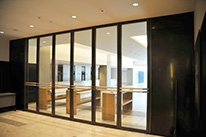
Entrance (2F/Main Hall)

View from the Entrance towards to the Foyer
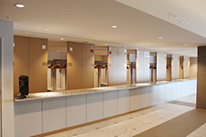
Cloakroom (2F/Main Hall)
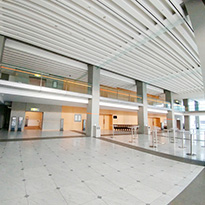
Foyer (2F/Main Hall)
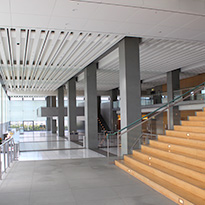
Foyer (2F/Main Hall)

Passage (1F/Main Hall)
-
Ensemble Hall Murata (Small Hall)
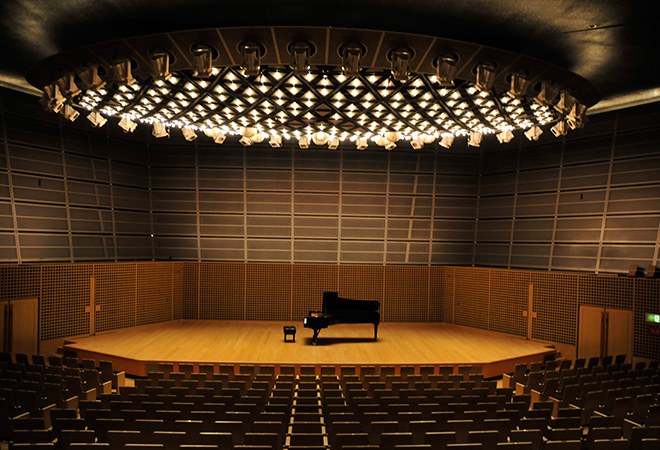
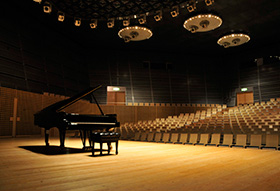
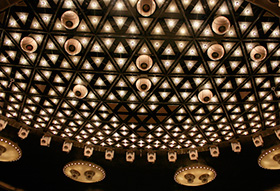
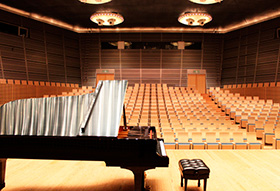
Seating for 514 (includes 4 wheelchair places) Foyer and cloakroom 2 small dressing rooms ; 2large dressing rooms
The space of the Ensemble Hall Murata is designed to provide optimal acoustics for performances by small orchestras of up to 30 members, or for piano or chamber-music recitals. Encompassed by an interior design that evokes a most unique atmosphere – stellar constellations on the ceiling, a huge lighting platform reminiscent of a hovering alien spacecraft, and lines of light that point to magnetic north – you will feel so intimately close to the music that you and the performer will seem to be breathing as one. The Ensemble Hall Murata is a sort of mini-universe specially created for close encounters with music. It is place for you to give yourself over to total enjoyment of a piano solo, or the pure strains of a string ensemble.
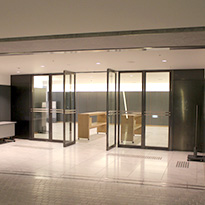
Entrance (3F/Ensemble Hall Murata)

from the Entrance towards to the Foyer(4F)
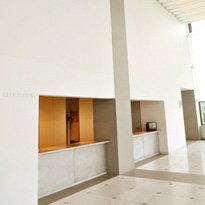
Cloakroom (4F/Ensemble Hall Murata)
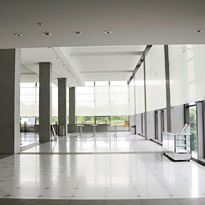
Foyer (4F/Ensemble Hall Murata)
-
Entrance Hall
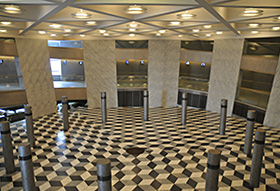
The Entrance Hall evokes a foretaste of the world of musical inspiration you are about to enter. In its center, twelve pillars, representing the twelve zodiac symbols of ancient Eastern chronology like a western astrology – the rat, the ox, the tiger, the hare, and so on – are set at regular intervals, and their rhythmical placement instills a sense of anticipation of the musical intoxication to come. Thus the prelude to every concert begins here, in the Entrance Hall.
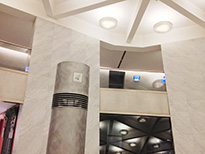
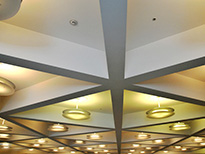
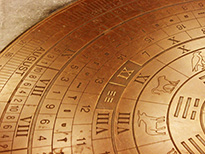
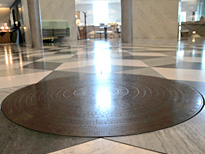
-
Incline
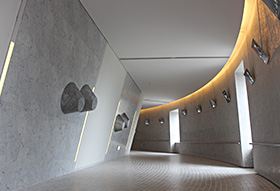
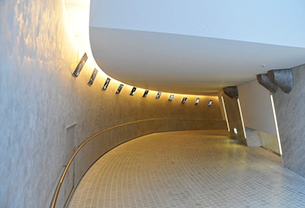
The gentle slope of its spiraling floor forms a runway on which you begin the spiritual transition from citizen of the world outside to visitor in a realm of pure musical immersion. This incline leads, with a stately and solemn majesty befitting this “place of classical music”, to the Concert Hall and the Ensemble Hall Murata.
-
Foyer
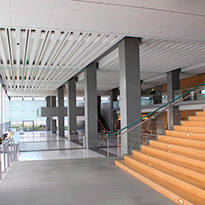

The more moving the performance, the more one appreciates a place to quietly savor the lingering aftertaste of the music. The Foyer, enclosed by screens of translucent glass that mute the direct rays of the sun, offers views of the mountains far to the west and the lush verdure of Kyoto’s Botanical Gardens in the foreground. This liberating yet restful atmosphere is ideal for a relaxing and intimate post-concert chat over wine or coffee – nothing brightens conversation like the afterglow of exciting concert. The open floor area at the foot of the stairs is designed to serve as a stage for lecture-concert and the like.
-
Outside view of the Kyoto Concert Hall

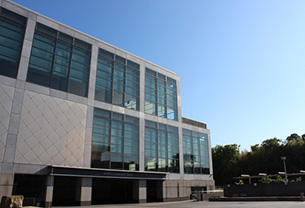
To the south of the walkway leading to the main entrance, a tidy arrangement of a rust-granite bridge, benches, and sculptures forms a sort of Japanese-style garden. The modern architecture of the Concert Hall is reflected in the clear waters of the pool, and the faint ripples on the water’s surface make a visual music of their own.
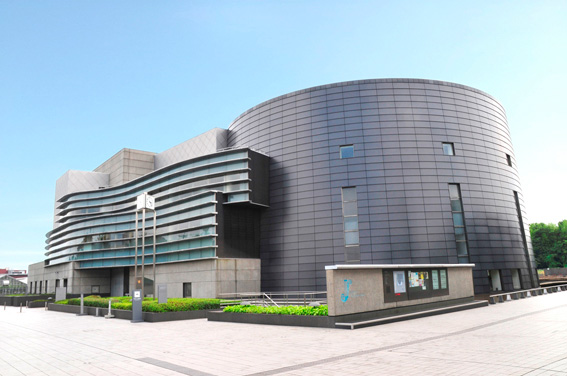
A look at the Concert Hall from the outside reveals an austerely gleaming edifice in muted grays, marked by an air of quiet refinement. Each of the three primary blocks that make up the building – the Concert Hall (Main Hall), the Ensemble Hall Murata, and the Foyer – is oriented along a line with a distinctively Kyoto significance: respectively, the boundary of the ancient capital, Heiankyo; Kitayama Street; and the Kamogawa River.
-
Ticket counter
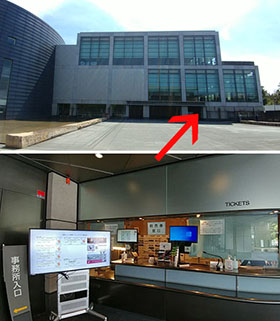
You can reserve tickets for concerts (except for some performances) performed at Kyoto Concert Hall and ROHM Theatre Kyoto. Cash or credit cards accepted.
* We accept the following credit cards: DC, UFJ, NICOS, Visa, Mastercard, JCB, Diners Club, American Express, and UnionPay.
●Kyoto Concert Hall
10:00 – 17:00 (closed on the 1st and the 3rd Monday of every month) -
Car Park
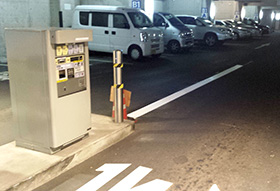
Basement Levels 1 and 2; Parking for about 100 vehicles.
Open every 08:30 – 23:00 except closed days(closed on the 1st and the 3rd Monday of every month and New Year Holidays.), vehicles must be 2.1 m in height or less.
Charge 250 yen for every 30 minutes.
We are open for everyone who needs parking even if you are not coming for the concert. -
The renowned instruments producing the exquisite melodies of the Kyoto Concert Hall
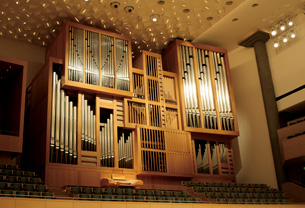
Pipe Organ
Johannes Klais Orgelbau GmbH & Co. KG, of Germany
90 stops 7,155 pipes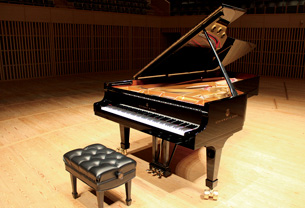
Steinway & Sons D274
(88 keys)
No.530245 / No.586008 / No.598956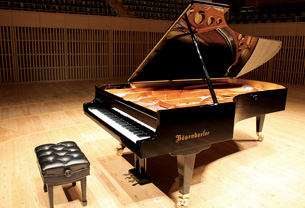
Bösendorfer 290
(97 keys)
Imperial No.43376-665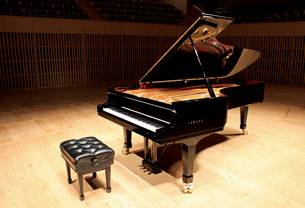
YAMAHA CFⅢS
No.S5335000
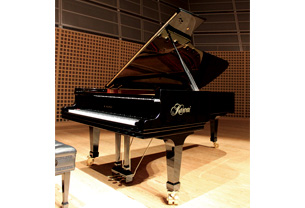
KAWAI EX
No.2095001
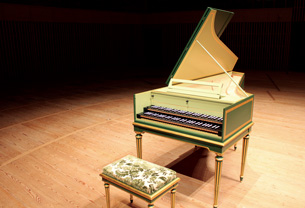
Cembalo
VONNAGEL PARIS
1994#796-94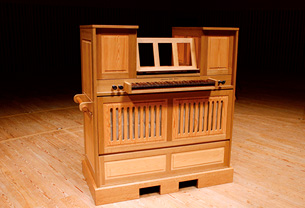
Positive Organ
(216 pipes)
Johannes Klais Orgelbau GmbH & Co. KG, of Germanyand others; YAMAHA C7 No.5390858 (Main Hall Dressing room A),KAWAI US-9X No.2165120 (Main Hall Dressing room B),YAMAHA YU5 No.5939945 (Ensemble Hall Murata Dressing room G)
Backstage facilities
-
Artists' Entrance (Stage door)
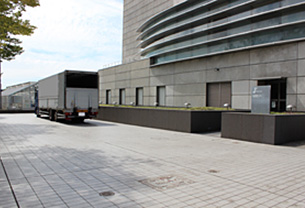
You will find the Stage door from the intersection Kitayama (Go up to Kitayama station exit 1 ) to south-west side.
-
Main Hall Dressing room
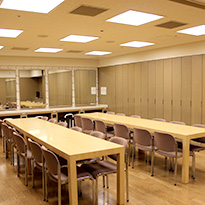
Dressing room 1
(56.7㎡ 30 persons)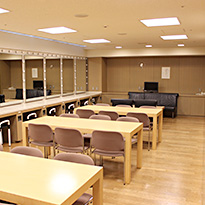
Dressing room 2
(62.7㎡ 30 persons)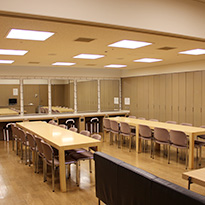
Dressing room 3
(67.7㎡ 30 persons)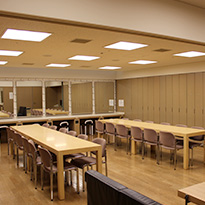
Dressing room 4
(67.7㎡ 30 persons)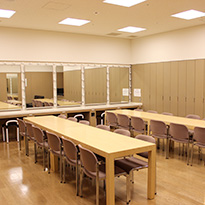
Dressing room 5
(54.3㎡ 30 persons)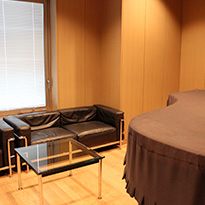
Dressing room A
(33.3㎡ 1 person)
with Grand Piano, Shower room, Restroom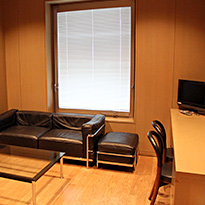
Dressing room B
(27㎡ 1 person)
with Upright Piano, Shower room, Restroom
Dressing room C
(23.1㎡ 1 person)
with Restroom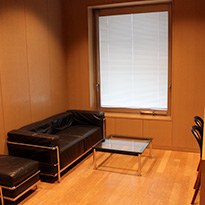
Dressing room D
(23.2㎡ 1 person)
with Restroom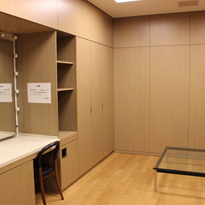
Dressing room E
(18㎡ 4 person)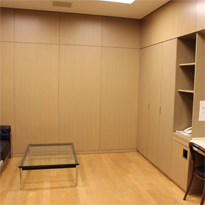
Dressing room F
(19㎡ 4 person)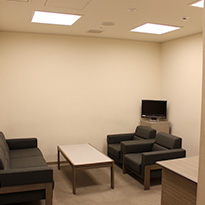
Staff room
(14.9㎡ 4 persons)
Artists' Lounge
-
Ensemble Hall Murata (Small Hall) Dressing room
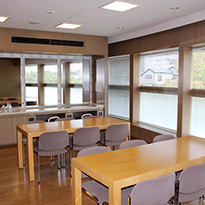
Dressing room 6
(38.5㎡ 15 persons)
Dressing room 7
(28.7㎡ 15 persons)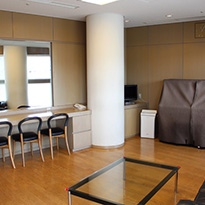
Dressing room G
(39.5㎡ 4 persons)
with Upright Piano, Shower room, Restroom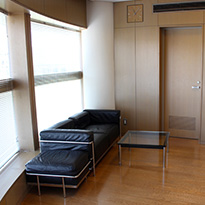
Dressing room H
(21.7㎡ 2 persons)
with Restroom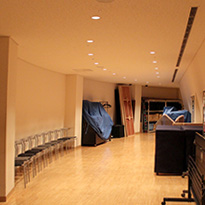
Artists Lounge
-
Loading Bay
 Calender
Calender
 Main Hall Seating Chart
Main Hall Seating Chart View of the Main Hall Stage from Each Seating Area
View of the Main Hall Stage from Each Seating Area